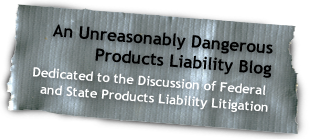Not too long ago, we here at Abnormal Use chronicled the saga of Buckyballs in the company’s two year fight against the draconian measures of the Consumer Product Safety Commission to take spherical desktop magnets from the marketplace. When Buckyballs eventually settled with the CPSC, Colorado-based Zen Magnets seized the torch in the fight against the CPSC over the right to manufacture and distribute spherical magnets. Back in 2014, Shihan Qu of Zen Magnets described his reasons for continuing the fight as follows:
I have two very distinct but related motives for continuing this fight.
The first one is obvious. I want to win. I want to keep selling magnets. I want to continue seeing the passion, joy, and inspiration they bring. I want to stay in business. I want to see a victory for magnets.
But number two, I want the CPSC to LOSE. I really really want them to lose. They need some humility and to be reminded of the standard of liberty in this country.
The single biggest issue that must be challenged, the aspect that makes this a landmark case, is that this is the first time the CPSC is arguing that warnings don’t work, which has incredibly vast policy implications. Putting warnings on this is mostly what the CPSC does. Small parts, choking hazards, etc.
Warnings are a sort of agreement a customer accepts upon use of a product. And by assuming that people cannot follow — by the way, there is still nobody who can confirm even a single Zen Magnet ingestion incident — instructions to keep magnets away from children and mouths, they are assuming the American Population is not capable of deciding for themselves. They are taking your right to consent, and fleecing your freedom to do as you will.
We’re the last line of defense, and if Zen Magnets doesn’t stand up, the CPSC gains a remarkable amount of power from consumers. They show the ability to determine behind their closed walls, what America can and can’t have, despite roaring public opposition. They set the precedence of creating an all-ages, nation-wide ban, with the assumption that an American cannot be “expected” to understand or follow warnings.
At long last, we are pleased to report that Qu’s mission has been accomplished (for the most part). By order dated March 25, 2016, Administrative Law Judge Dean Metry found that small rare earth magnets (“SREMs”) are not defective, did not contain inadequate warnings, and, when sold with appropriate warnings, are not substantial product hazards. In other words, Qu’s reasons for fighting were not in vain. The case is captioned, In the Matter of Zen Magnets, LLC, CPSC Docket No. 12-2 (March 25, 2016).
As you may recall, the CPSC has argued that SREMs are defective because ingesting the magnets creates a serious risk of injury. While the ALJ agreed that ingesting SREMs can result in serious injury, ingestion is a misuse of the product and not part of the product’s normal operation and use. SREMs, when used properly, are harmless. As such, the ALJ found that SREMs are not defective under 16 C.F.R. 1115.4.
The CPSC also argued that SREMs were defective because the product warnings were inadequate in mitigating the risk. Specifically, the CPSC took issue that a warning label could not be placed on each individual SREM due to the magnets small size and, thus, any persons who obtain lost or shared SREMs will not see any warnings. The ALJ didn’t buy it. As of at least 2012, Zen Magnets contained warnings, including our personal favorite:
OMFG READ ME
This is serious! The grumpy CPSC is about to BAN magnet spheres in the US because they are an ingestion hazard. They don’t trust that you are capable of understanding and following warnings. Prove them wrong, or we all can’t have nice things. Zen Magnets, LLC, the producer of Neoballs, has had no record of ingestion and we’d like to keep it that way. High powered magnets can cause potentially fatal intestinal pinching if swallowed. Keep magnet spheres away from all orifices (sic), especially the mouth and nose. High powered magnets are not a toy. Keep away from anybody who does not understand these dangers. SRSLY.
The ALJ found that the warnings, including our favorite above, did not contain any fault, flaw, or irregularity. In fact, the ALJ stated “[i]t would be near absurdity to fault [Zen Magnets] for not labeling each individual SREM with a warning.”
Notwithstanding these findings, the ALJ found that prior to May 2010, ZEN Magnets sold some SREMs without warnings and with a suggested age of 12 (rather than 14) and above. As such, those products sold before 2010 are considered toys and substantial product hazards under the Standard for Consumer Safety Specification for Toy Safety. Accordingly, the ALJ granted the CPSC partial relief and required Zen Magnets to compile a list of pre-May 2010 purchasers and offer them a full refund. Ultimately, however, Zen Magnets has to consider this decision a huge win for spherical magnets.
Interestingly, if one were to look for news reports on the ALJ Order, they are nowhere to be found. However, the news is filled with reports like this one about the recent recall of “dangerous” magnets. Those reports arise out of a March 22, 2016 decision from a a related case pending in the U.S. District Court for the District of Colorado involving Zen Magnets sale of certain recalled products it acquired from another company (Star Networks USA) after that company reached a settlement with the CPSC. So, not quite the indictment on Zen’s SREMs the reports may suggest. We will assume their reports on the ALJ decision are forthcoming.

















